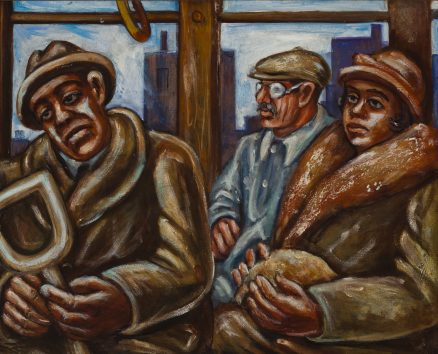Untitled (Cottage Grove Street Car)
, circa 1940sOil on canvas, 24 by 301/16 inches
- Zoom in on Artwork
- Print Page
- Email Page to Friend
In Morris Topchevsky’s tightly framed composition, three figures encased in bulky winter outerwear are packed into a city streetcar. Next to a woman in a fur-trimmed coat, a bespectacled man with lined cheeks gazes out the window at the passing urban scene. The formal attire of another passenger—a Homburg hat and overcoat, a white shirt and a tie showing beneath his chin—contrasts with the object in his hands, apparently the handle of a stout shovel. The three riders seem unconnected from one another and resigned to the boredom of a familiar journey, with the tilted head and anxious expression of the man with the shovel hinting at unknown cares. Topchevsky’s palette evokes the dreary chill of winter in the city. Soft dull browns and greens tie the clothing of the two nearer figures to the wooden framework of the streetcar windows, while the muted gray of the coat worn by the man in the middle echoes the blue-white of the frigid sky beyond, reflected in his glasses.
Painting in Chicago and Mexico, Topchevsky made working-class people the focus of his art throughout his career. In sympathetic images of laborers and strikers he showed Black and white workers together, united in a heroic struggle for justice. In addition, he painted scenes of everyday life in Chicago’s African American neighborhood known as Bronzeville, where between the early 1930s and the end of his life he lived and taught at the Abraham Lincoln Center, on Cottage Grove Avenue. Often his images address the precarious existence of Black Chicagoans in an era of mass unemployment and Jim Crow segregation. Untitled (Cottage Grove Street Car), however, is uncharacteristically nuanced for Topchevsky. The three passengers are dignified and elegantly dressed, seemingly at home in the modern city. Yet the prominent shovel incongruously held by the well-attired man on the left hints at necessity and the restricted opportunities available to African Americans not only in employment but also in housing, education, entrepreneurship, and other areas.
The heavily outlined, powerfully modeled forms seen here are typical of Topchevsky’s paintings of the early 1940s. Throughout his career the artist worked in a deliberately anti-academic manner influenced by the “naïve” aesthetic of Mexican social realist artists and possibly also inspired by traditional Russian peasant arts. This painting is likely the work titled Cottage Grove Street Car included in a memorial exhibition for Topchevsky organized by the American Jewish Arts Club in December 1947. The streetcar, which the artist himself would have ridden frequently, was the subject of an earlier watercolor painting In a Street Car, shown in exhibitions of art created under the auspices of the Federal Art Project held in New York and in Chicago in 1938.
Wendy Greenhouse, PhD
Donated by M. Christine Schwartz to the Jane Addams Hull-House Museum, Chicago, Illinois, in 2023
